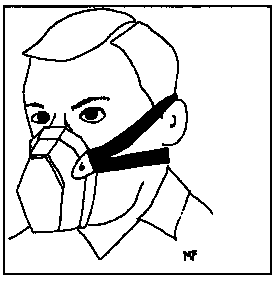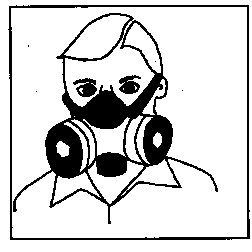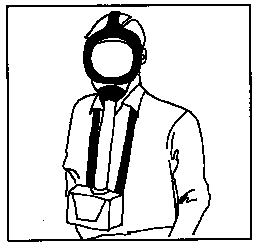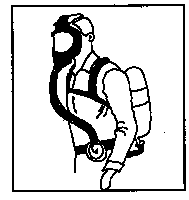Table
of Contents
Introduction
Choosing the Proper Equipment
Hazardous Sources and Their Contaminants
Places Where You Can Buy Respiratory Equipment
Respiratory Equipment Safety
In Case of Emergency
Introduction
Who Needs Respiratory Protection?
If you work in any one of these situations and do not wear some form of respiratory protection, then you are placing yourself at risk for serious lung diseases or even death.
You may encounter a range of health problems from minor, temporary discomfort caused by allergic reactions to fatal asphyxiation depending upon the work environment and the hazards presented.
In each of these cases, however, proper respiratory equipment can protect you. Using such equipment is not the only means of protection in all of these cases, but it is a practical solution to safeguard and even improve your health.
Choosing the Proper EquipmentThere are several types of protective equipment available for all tasks. They are broken down into two categories:
Air
Purifying Respiratory Protection
 Mechanical
filter respiratory protection devices are commonly known as
dust masks. These simple filters commonly consist of a molded
filter designed to cover the nose and mouth. The filter is held
in place by one or two elastic straps that are stretched over
the head. Some of these type masks have a valve made into the
filtering substance to allow easier breathing. When the filter
becomes clogged, the complete unit is discarded. Units having
two straps fit better.
Mechanical
filter respiratory protection devices are commonly known as
dust masks. These simple filters commonly consist of a molded
filter designed to cover the nose and mouth. The filter is held
in place by one or two elastic straps that are stretched over
the head. Some of these type masks have a valve made into the
filtering substance to allow easier breathing. When the filter
becomes clogged, the complete unit is discarded. Units having
two straps fit better.
Dust masks provide protection against airborne dust particles (chemical, mineral, field or barn, chaff, pollen) and non-toxic paint spray dusts. Sufficient levels of oxygen must be present in the air to be filtered.
Chemical
Cartridge Respirators
Chemical cartridge respirators provide a higher level of protection
than dust masks. A soft rubber-like face piece (silicone) covers
the nose and mouth and contains valves to control  air movement
through the device. A full face respirator also contains a lens
to cover the eyes. Replaceable cartridges containing activated
carbon are used to filter the incoming air. Prefilters are usually
installed on the outside of the cartridges. Elastic straps or
harness are used to hold the respirator snugly against the user's
face. A half mask covers only the nose and mouth of the user.
A full face respirator also includes an eye shield and covers
the entire face and eyes.
air movement
through the device. A full face respirator also contains a lens
to cover the eyes. Replaceable cartridges containing activated
carbon are used to filter the incoming air. Prefilters are usually
installed on the outside of the cartridges. Elastic straps or
harness are used to hold the respirator snugly against the user's
face. A half mask covers only the nose and mouth of the user.
A full face respirator also includes an eye shield and covers
the entire face and eyes.
The user must anticipate the type of hazard to be protected against and purchase the correct cartridges. Most cartridges are designed to provide protection for a specific type of chemical hazard such as pesticides, ammonia, anhydrous ammonia, etc. Sufficient levels of oxygen must be present in the air to be filtered.
Gas
Masks
 Gas
masks have full face coverage. The filtering cartridge or canister
has a larger capacity than a cartridge type respirator. The
cartridge may be mounted on the face piece or at the end of
a flexible hose to allow mounting at the user's belt. Sufficient
levels of oxygen must be present in the air where gas masks
are used.
Gas
masks have full face coverage. The filtering cartridge or canister
has a larger capacity than a cartridge type respirator. The
cartridge may be mounted on the face piece or at the end of
a flexible hose to allow mounting at the user's belt. Sufficient
levels of oxygen must be present in the air where gas masks
are used.
Gas masks provide protection against pesticides, and often toxic airborne materials. The greater capacity of gas mask cartridges (canisters) allows longer working times in high levels of contaminants than typical respirators.
Supplied-Air Respiratory Protection Supplied-air respirators provide fresh air from a remote source or from pressurized tanks. The face pieces are similar to cartridge type respirators or gas masks. The air may be supplied by a portable air compressor or pressure tanks located up to 300 feet from the user. Compressors must be located in a clean air area.
 Supplied-air respirators can be used in confined spaces where
there is likely to be an inadequate level of oxygen.
Supplied-air respirators can be used in confined spaces where
there is likely to be an inadequate level of oxygen.
SELF-CONTAINED BREATHING APPARATUS (SCBA) is a type of respirator that has full face coverage and an oxygen supply contained in a compressed air tank carried on the users back. It can be used in oxygen deficient areas and in hazardous atmospheres.
A self-contained breathing apparatus can be used where ever the user must work, such as in silos, manure pits, grain storage and fumigation of structures.
Hazardous
Sources and Their Contaminants
The
table below identifies some common hazardous sources and their
potential contaminants. It briefly summarizes situations where
you should use protective equipment to guard against dangerous
elements that may be present in the listed work environments--YOUR
work environment.
| SILAGE | MANURE PITS | CONFINED POULTRY HOUSING | CONFINED HOG HOUSING | PESTICIDES |
|---|---|---|---|---|
| CO2
nitrogen oxides mold spores |
ammonia methane CO2 hydrogen sulfide |
DUSTS: feathers and feather particles dried skin material dried fecal material dried feed products
GASES: |
DUSTS: hair and skin particles dried feed products dried fecal particles
GASES: |
TOXIC: fumes gases mists dusts |
If you are not sure which type of protective equipment is best for the work you do, then ask the professionals who sell the various products.
Places
Where You Can Buy Respiratory Equipment
You
can probably find most types of equipment at a safety supply
store, but farm supply stores and agricultural chemical suppliers
are also good sources. If any of these suppliers do not have
the equipment you need, they can likely order it for you or
tell you how you can order it yourself. Places that test-fit
the respiratory device to ensure a proper fit are the best places
to purchase your equipment.
For information concerning the selection and use of respiratory equipment, contact local agricultural stores, safety supply stores, pesticide sales outlets, or the Virginia Cooperative Extension.
Respiratory
Equipment Safety
Respiratory
equipment can safeguard your health and save your life in any
hazardous air condition you may encounter. However, without
proper care and precautions when using such equipment, the device
you rely on could be ineffective. Here is a list of guidelines
and precautions every worker should follow when using protective
equipment.
2) Negative Fit Check. Cover the cartridge(s) with your hands and inhale -- if the mask is drawn tightly to your face, there is no leakage.
If you are using a pre-filter for more than five or six hours a day, then you should change the filter daily. It is important to change filter cartridges before breathing becomes difficult.
Caution: Often, it is necessary to use other protective equipment and clothing when using respiratory protective equipment, such as special gloves, eye protection, and long sleeve shirts.
| In Case
of Emergency If you suddenly feel SICK, DIZZY or CANNOT BREATHE properly, leave the hazardous area immediately. If someone else is overcome by toxic gases:
2. Remove the victim to fresh air. |
Glen H. Hetzel, Extension Agricultural Engineer Virginia Tech
Disclaimer and Reproduction Information: Information in NASD does not represent NIOSH policy. Information included in NASD appears by permission of the author and/or copyright holder. More